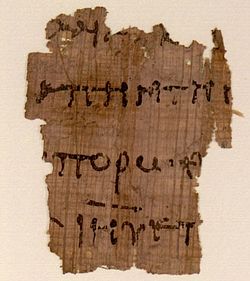Papyrus 111
| Papyrus 111 | |
|---|---|

|
|
| Surname | P. Oxy. LXVI 4495 |
| text | Luke 17: 11-13, 22-23 |
| language | Greek |
| date | 3rd century |
| Found | Oxyrhynchus , Egypt |
| Storage location | Sackler Library |
| source | WEH Cockle, OP LXVI (1999), pp. 19-20 |
| size | [22] x [12] cm |
| Type | Alexandrian text type |
| category | no |
| note | agrees with 75 match |
Papyrus 111 (named after Gregory-Aland with Sigel 111 ) is an early Greek copy of the New Testament . This papyrus manuscript contains parts of the Gospel of Luke . The remaining text consists of poorly preserved fragments and comprises verses 17: 11-13; 17.22-23.
description
Using palaeography , INTF dated it to the 3rd century. Comfort places it in the first half of the 3rd century. The manuscript is currently on display in the papyrology rooms of the Sackler Library in Oxford under the number P. Oxy. 4495 kept.
text
The Greek text of the Codex represents the Alexandrian text type .
In Luke 17:12 the reading or text variant can be found:
- απηντησαν - also in 75 , in all other sources it says υπηντησαν.
In Luke 17:22 we find:
- του επιθυμησαι ( to be desired ) - as well as Codex Bezae , f 13 , 157 . Other testimonies have οτε επιθυμησητε ( if [you] wish ).
Individual evidence
- ^ A b Philip W. Comfort, Encountering the Manuscripts. An Introduction to New Testament Paleography & Textual Criticism , Nashville, Tennessee: Broadman & Holman Publishers, 2005, p. 76.
- ^ JK Elliott, Seven Recently Published New Testament Fragments from Oxyrhynchus , Novum Testamentum XLII, p. 211.
See also
literature
- WEH Cockle, The Oxyrhynchus Papyri LXVI (London: 1999), pp. 5-7.
Web links
Illustrations
- P.Oxy.LXIV 4496 from Papyrology on Oxford's "POxy: Oxyrhynchus Online"
- Image by 111 recto
- Image of 111 verso
